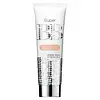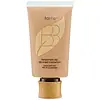Physician's Formula Super BB All-in-1 Beauty Balm Cream Versus Tarte Amazonian Clay BB Tinted Moisturizer
What's inside
What's inside
 Key Ingredients
Key Ingredients

 Benefits
Benefits

 Concerns
Concerns

 Ingredients Side-by-side
Ingredients Side-by-side

Titanium Dioxide
Cosmetic ColorantZinc Oxide
Cosmetic ColorantWater
Skin ConditioningCyclopentasiloxane
EmollientCaprylic/Capric Triglyceride
MaskingNeopentyl Glycol Diheptanoate
EmollientDimethicone
EmollientButylene Glycol
HumectantCetyl PEG/PPG-10/1 Dimethicone
EmulsifyingCetearyl Alcohol
EmollientC30-45 Alkyl Cetearyl Dimethicone Crosspolymer
EmollientPEG-10 Dimethicone
Skin ConditioningSodium Chloride
MaskingGlycerin
HumectantSalix Alba Bark Extract
AstringentButyrospermum Parkii Butter
Skin ConditioningPerilla Ocymoides Seed Oil
Skin ConditioningLysolecithin
EmulsifyingPolysilicone-11
Tetrahexyldecyl Ascorbate
AntioxidantTocopheryl Acetate
AntioxidantDisodium EDTA
Disteardimonium Hectorite
StabilisingGlyceryl Stearate
EmollientLaureth-12
EmulsifyingMagnesium Silicate
AbsorbentMica
Cosmetic ColorantPEG/PPG-18/18 Dimethicone
EmulsifyingPolysorbate 60
EmulsifyingPropylene Carbonate
SolventSodium Hydroxide
BufferingTriethoxycaprylylsilane
Xanthan Gum
EmulsifyingCaprylyl Glycol
EmollientEthylhexylglycerin
Skin ConditioningHexylene Glycol
EmulsifyingPhenoxyethanol
PreservativeTitanium Dioxide, Zinc Oxide, Water, Cyclopentasiloxane, Caprylic/Capric Triglyceride, Neopentyl Glycol Diheptanoate, Dimethicone, Butylene Glycol, Cetyl PEG/PPG-10/1 Dimethicone, Cetearyl Alcohol, C30-45 Alkyl Cetearyl Dimethicone Crosspolymer, PEG-10 Dimethicone, Sodium Chloride, Glycerin, Salix Alba Bark Extract, Butyrospermum Parkii Butter, Perilla Ocymoides Seed Oil, Lysolecithin, Polysilicone-11, Tetrahexyldecyl Ascorbate, Tocopheryl Acetate, Disodium EDTA, Disteardimonium Hectorite, Glyceryl Stearate, Laureth-12, Magnesium Silicate, Mica, PEG/PPG-18/18 Dimethicone, Polysorbate 60, Propylene Carbonate, Sodium Hydroxide, Triethoxycaprylylsilane, Xanthan Gum, Caprylyl Glycol, Ethylhexylglycerin, Hexylene Glycol, Phenoxyethanol
Water
Skin ConditioningCyclopentasiloxane
EmollientOctyldodecyl Neopentanoate
EmollientGlycerin
HumectantPEG/PPG-18/18 Dimethicone
EmulsifyingDimethicone
EmollientAluminum Hydroxide
EmollientStearic Acid
CleansingTriethoxycaprylylsilane
Saccharum Officinarum Extract
MoisturisingPyrus Malus Fruit Extract
Skin ConditioningCitrus Limon Fruit Extract
MaskingCitrus Aurantium Dulcis Fruit Extract
MaskingCamellia Sinensis Leaf Extract
AntimicrobialPanax Ginseng Root Extract
EmollientGinkgo Biloba Leaf Extract
Skin ConditioningChamomilla Recutita Flower Extract
MaskingKaolin
AbrasivePhytantriol
HumectantMagnesium Ascorbyl Phosphate
AntioxidantRetinyl Palmitate
Skin ConditioningTocopheryl Acetate
AntioxidantTocopherol
AntioxidantTetrahexyldecyl Ascorbate
AntioxidantButylene Glycol
HumectantMethicone
EmollientOctyldodecanol
EmollientBoron Nitride
AbsorbentPalmitic Acid
EmollientDextrin Palmitate
EmulsifyingSodium Hyaluronate
HumectantSodium Chloride
MaskingSodium Dehydroacetate
PreservativeHexylene Glycol
EmulsifyingCaprylyl Glycol
EmollientPhenoxyethanol
PreservativeMica
Cosmetic ColorantIron Oxides
Water, Cyclopentasiloxane, Octyldodecyl Neopentanoate, Glycerin, PEG/PPG-18/18 Dimethicone, Dimethicone, Aluminum Hydroxide, Stearic Acid, Triethoxycaprylylsilane, Saccharum Officinarum Extract, Pyrus Malus Fruit Extract, Citrus Limon Fruit Extract, Citrus Aurantium Dulcis Fruit Extract, Camellia Sinensis Leaf Extract, Panax Ginseng Root Extract, Ginkgo Biloba Leaf Extract, Chamomilla Recutita Flower Extract, Kaolin, Phytantriol, Magnesium Ascorbyl Phosphate, Retinyl Palmitate, Tocopheryl Acetate, Tocopherol, Tetrahexyldecyl Ascorbate, Butylene Glycol, Methicone, Octyldodecanol, Boron Nitride, Palmitic Acid, Dextrin Palmitate, Sodium Hyaluronate, Sodium Chloride, Sodium Dehydroacetate, Hexylene Glycol, Caprylyl Glycol, Phenoxyethanol, Mica, Iron Oxides
Ingredients Explained
These ingredients are found in both products.
Ingredients higher up in an ingredient list are typically present in a larger amount.
Butylene Glycol (or BG) is used within cosmetic products for a few different reasons:
Overall, Butylene Glycol is a safe and well-rounded ingredient that works well with other ingredients.
Though this ingredient works well with most skin types, some people with sensitive skin may experience a reaction such as allergic rashes, closed comedones, or itchiness.
Learn more about Butylene GlycolCaprylyl Glycol is a humectant and emollient, meaning it attracts and preserves moisture.
It is a common ingredient in many products, especially those designed to hydrate skin. The primary benefits are retaining moisture, skin softening, and promoting a healthy skin barrier.
Though Caprylyl Glycol is an alcohol derived from fatty acids, it is not the kind that can dry out skin.
This ingredient is also used as a preservative to extend the life of products. It has slight antimicrobial properties.
Learn more about Caprylyl GlycolCyclopentasiloxane, or D5, is a silicone used to improve texture of products and trap moisture.
D5 is considered lightweight and volatile. Volatile means it evaporates quickly after application. Once evaporated, D5 leaves a thin barrier that helps keep skin hydrated.
It is also an emollient. Emollients help soften the skin and prevent water loss. Silicones create a silky texture in products. D5 helps other ingredients become more spreadable.
Studies show D5 is safe to use in skincare products. We recommend speaking with a skincare professional if you have concerns.
Learn more about CyclopentasiloxaneDimethicone is a type of synthetic silicone created from natural materials such as quartz.
What it does:
Dimethicone comes in different viscosities:
Depending on the viscosity, dimethicone has different properties.
Ingredients lists don't always show which type is used, so we recommend reaching out to the brand if you have questions about the viscosity.
This ingredient is unlikely to cause irritation because it does not get absorbed into skin. However, people with silicone allergies should be careful about using this ingredient.
Note: Dimethicone may contribute to pilling. This is because it is not oil or water soluble, so pilling may occur when layered with products. When mixed with heavy oils in a formula, the outcome is also quite greasy.
Learn more about DimethiconeGlycerin is already naturally found in your skin. It helps moisturize and protect your skin.
A study from 2016 found glycerin to be more effective as a humectant than AHAs and hyaluronic acid.
As a humectant, it helps the skin stay hydrated by pulling moisture to your skin. The low molecular weight of glycerin allows it to pull moisture into the deeper layers of your skin.
Hydrated skin improves your skin barrier; Your skin barrier helps protect against irritants and bacteria.
Glycerin has also been found to have antimicrobial and antiviral properties. Due to these properties, glycerin is often used in wound and burn treatments.
In cosmetics, glycerin is usually derived from plants such as soybean or palm. However, it can also be sourced from animals, such as tallow or animal fat.
This ingredient is organic, colorless, odorless, and non-toxic.
Glycerin is the name for this ingredient in American English. British English uses Glycerol/Glycerine.
Learn more about GlycerinHexylene Glycol is a surfactant. Glycols are a class of alcohols. Hexylene Glycol is a surfactant and emulsifier.
As a surfactant, Hexylene Glycol helps gather dirt and oil on your skin to be washed away.
As an emulsifier, Hexylene Glycol helps keep water and oil together. This prevents them from separating in a product. Hexylene Glycol also thins out the texture of a product by lessening viscosity.
Hexylene Glycol has a small molecular weight.
Learn more about Hexylene GlycolMica is a naturally occurring mineral used to add shimmer and color in cosmetics. It can also help improve the texture of a product or give it an opaque, white/silver color.
Serecite is the name for very fine but ragged grains of mica.
This ingredient is often coated with metal oxides like titanium dioxide. Trace amounts of heavy metals may be found in mica, but these metals are not harmful in our personal products.
Mica has been used since prehistoric times throughout the world. Ancient Egyptian, Indian, Greek, Roman, Aztec, and Chinese civilizations have used mica.
Learn more about MicaPEG/PPG-18/18 Dimethicone is a type of silicone.
Phenoxyethanol is a preservative that has germicide, antimicrobial, and aromatic properties. Studies show that phenoxyethanol can prevent microbial growth. By itself, it has a scent that is similar to that of a rose.
It's often used in formulations along with Caprylyl Glycol to preserve the shelf life of products.
Chances are, you eat sodium chloride every day. Sodium Chloride is also known as table salt.
This ingredient has many purposes in skincare: thickener, emulsifier, and exfoliator.
You'll most likely find this ingredient in cleansers where it is used to create a gel-like texture. As an emulsifier, it also prevents ingredients from separating.
There is much debate on whether this ingredient is comedogenic. The short answer - comedogenic ratings don't tell the whole story. Learn more about comegodenic ratings here.
The concensus about this ingredient causing acne seems to be divided. Research is needed to understand if this ingredient does cause acne.
Scrubs may use salt as the primary exfoliating ingredient.
Learn more about Sodium ChlorideTetrahexyldecyl Ascorbate (THD) is a stable and oil-soluble form of Vitamin C.
THD is special in that it has the ability to travel deeper into skin than traditional ascorbic acid while maintaining the same skin benefits (double win!).
Because it’s oil-soluble, THD dives deep into your skin’s fatty layers (think ceramides and cholesterol) to fight off the kind of free radicals that mess with your skin barrier. This makes it a great pair with water-based vitamin C (ascorbic acid) that mainly works on the surface.
Even at just 0.1%, THD is already showing great antioxidant activity. When used up to 2%, it helps keep your skin happy and calm, especially when it’s stressed from pollution or sun.
Want to fade dark spots or tackle hyperpigmentation? You’ll want 5% or more. Pairing it with brightening buddies like niacinamide or licorice root gives even better results. One study even used 30% THD with other brighteners and saw real results on stubborn discoloration, even in melasma-prone skin.
A note on THD: It’s has a slightly silky, oily texture and usually shows up colorless or pale yellow (though the exact shade can vary by supplier).
While you can sneak it into water-based formulas, it really shines when paired with silicones or oils, which help your skin soak it up better.
THD is pretty stable, but it’s still vulnerable to degradation like ascorbic acid. Too much light or heat (above 113°F / 45°C) can break it down over time. Go for dark and opaque packaging that keeps it safe and shady!
Read more about other types of Vitamin C:
Learn more about Tetrahexyldecyl AscorbateTocopheryl Acetate is AKA Vitamin E. It is an antioxidant and protects your skin from free radicals. Free radicals damage the skin by breaking down collagen.
One study found using Tocopheryl Acetate with Vitamin C decreased the number of sunburned cells.
Tocopheryl Acetate is commonly found in both skincare and dietary supplements.
Learn more about Tocopheryl AcetateTriethoxycaprylylsilane is a silicone used to bind and stabilize ingredients.
As an emulsifier, it helps prevent ingredients from separating. This can help elongate the shelf life of products.
Triethoxycaprylylsilane is often used to coat mineral sunscreens ingredients to help give a better feel. It also helps reduce oxidative stress in sunscreens.
Learn more about TriethoxycaprylylsilaneWater. It's the most common cosmetic ingredient of all. You'll usually see it at the top of ingredient lists, meaning that it makes up the largest part of the product.
So why is it so popular? Water most often acts as a solvent - this means that it helps dissolve other ingredients into the formulation.
You'll also recognize water as that liquid we all need to stay alive. If you see this, drink a glass of water. Stay hydrated!
Learn more about Water